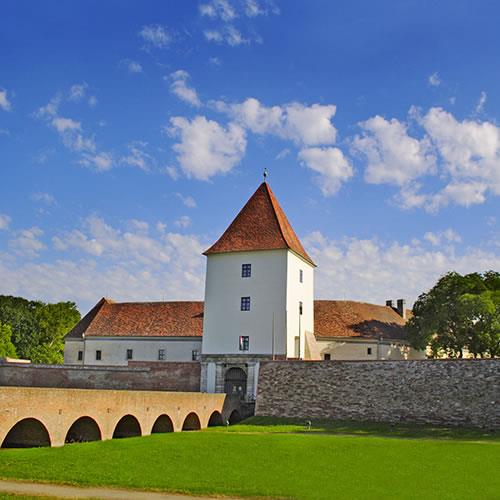close X
Budapest
Two cities in one! Buda on a hill, the historical part of the city and Pest on a plain, its shops and boulevards both separated by the Danube flowing between them and connected by magnificent bridges. Budapest looks its most beautiful at dawn, yet it is also spectacularly appealing at night. With a unique, youthful atmosphere, a world-class classical music scene as well as a pulsating nightlife and an exceptionally rich offering of natural thermal baths, Budapest is one of Europe's most delightful and enjoyable cities. This is a vibrant city - a remarkable and wholly unpretentious place.
Visit and explore Buda Hill and the Castle District, Parliament, the Chain Bridge, Heroes' Square, St. Stephen's Basilica, the Opera House, Matthias Church, Fisherman's Bastion, Gellert Hill, the thermal baths and so much more!
close X
Pecs
Pécs is the largest city in the Southern Transdanubia region of Hungary, situated about 20 miles west of the Danube River and 20 miles north of the border with Croatia. During the Roman era, the city was called Sopianae and was a center of Christianity during the first few centuries of the Common Era. The ruins of a 4th-century necropolis are listed on the register of UNESCO World Heritage Sites. As a result of multiple conquests from different ethnic groups, there are a mix of cultural influences seen here, such as the oldest university in Hungary, founded by the Magyars; and the Mosque of Pasha Qasim Victorious, from the 150-year rule imposed by the Ottomans. Pécs is a UNESCO City of Peace as well as a former European Capital of Culture.
Visit and discover the great Mecsek Mountains, Zsolnay Cultural Quarter, Mosque of Pasha Qasim, Pecs Cathedral, Pecs TV Tower, Pecs Zoo, Victor Vasarely Museum, Szechenyi Square, Zengo, Csontvary Museum, and so much more.
close X
Gyor
Gyor is the principal city in the Western Transdanubia region of Hungary, located halfway between Vienna and Budapest. The city was founded by the Celts in the 5th century BCE; it was also a Roman settlement in the province of Pannonia called Arrabona. The Magyars arrived in the year 900 CE and gave the town its current name. The buildings you will see in the city today were built from the time of the Renaissance, when Gyor saw a resurgence, to the 19th century, when it boomed as a port on the Danube River. Gyor is in fact located at the confluence of three rivers: the Danube, the Raba, and the Rabca. Important sights in the area include the 15th-century Doczy Chapel; the Gothic-Baroque-hybrid Gyor Cathedral; the Museum of Roman Archaeology; and about 12 miles out of town, the Pannonhalma Archabbey, a UNESCO World Heritage Site.
Be the first to visit the Cathedral Basilica of the Assumption of Our Lady (Gyor Cathedral), Xantus Janos Zoo, Carmelite temple, Szechenyi Square, Museum of Roman Archaeology, Pannonhalma Archabbey, Pannonhalma Protected Area, Doczy Chapel, and so much more.
close X
Andrassy Avenue and Heroes Square
Enjoy the extensive Andrassy Avenue and Heroes Square on your visit to Budapest. The historical Andrassy Avenue connects Elizabeth Square with Heroes Square, ending at the City Park, one of Budapest's most popular green spaces. Established in 1872, it houses a host of remarkably Eclectic Neo-Renaissance mansions and palaces in Budapest, all of which were designed by renowned architects. Moreover, the Millennium Underground was the first metro line in continental Europe and the second one in the world, completed for Hungary's Millennial jubilee in 1896.
close X
Andrassy Avenue and Heroes Square
Enjoy the extensive Andrassy Avenue and Heroes Square on your visit to Budapest. The historical Andrassy Avenue connects Elizabeth Square with Heroes Square, ending at the City Park, one of Budapest's most popular green spaces. Established in 1872, it houses a host of remarkably Eclectic Neo-Renaissance mansions and palaces in Budapest, all of which were designed by renowned architects. Moreover, the Millennium Underground was the first metro line in continental Europe and the second one in the world, completed for Hungary's Millennial jubilee in 1896.
close X
Balatonalmadi
Balatonalmádi is actually a large town that was once three separate villages -- Balatonalmádi, Káptalanfüred, and Vörösberény -- all clustered on the northern shore of Lake Balaton. Where the center of town sits today was once a large vineyard. When the vineyards died off at the start of the 20th century, the landowners decided to build rental homes to make the area a vacation destination for the middle class. After over 100 years, it is still one of the more popular resort towns on Lake Balaton. There are beaches close to the center of town which offer various water sporting activities, and there is also a state-of-the-art marina for those wanting to enjoy a day (or more) on the water. Points of interest include the walled Reformed Church of Vörösberény, a Calvinist church dating from the 18th century.
Discover the great Balatonalmádi, Káptalanfüred, Vörösberény, Reformed Church of Vörösberény, Fuzfo-obol, Káptalanfüred Beach, Sherpa Adventure Park, and so much more.
close X
Balatonfured
The oldest and most popular of the resort towns on Lake Balaton`s northern shore, Balatonfüred is well-known not only for its mineral spas, which have brought travelers to the area for nearly 250 years, but also for its world-class marina and its yachting opportunities. People also travel to Balatonfüred for sun and swimming, as evidenced by the numerous beaches dotting the shoreline, such as Esterházy Beach, Kisfaludy Beach, and Csopak Beach. Visitors are in for a treat if they get a chance to sample the famed local Welschriesling wine.
Visit and discover the great Annagora Waterpark, Koloska Valley, Tihany Abbey, Tihany Peninsula, Esterházy Beach, Kisfaludy Beach, Csopak Beach, Loczy Cave, Baratlakasok Volcano, and so much more.


